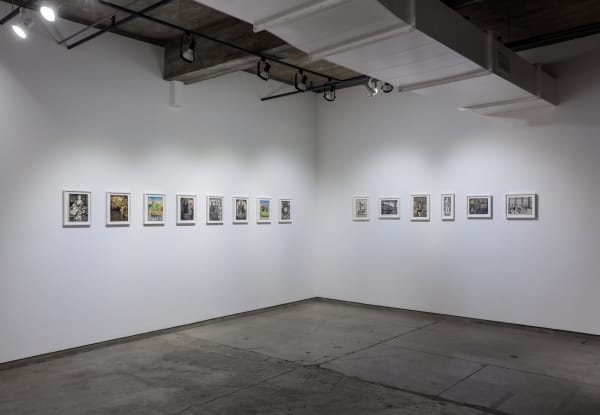Renaldo Kuhler: Rocaterrania
In his thirty-year career as a scientific illustrator, Renaldo Kuhler (American, 1931-2013) created hundreds of plates for the North Carolina Museum of Natural Sciences, illustrating diverse flora and fauna for scientific journals, reference books, and exhibits. Unbeknownst to family, friends, and coworkers, Kuhler was also a prolific self-taught artist.
The only son of German-born Otto Kuhler, a renowned industrial designer of streamline steam engines during the Art Deco period, Kuhler was bullied and ridiculed as a child by classmates, teachers, and headmasters simply for being “different.” When the family moved from upstate New York to a remote cattle ranch in the Colorado Rockies in 1948, teenaged Kuhler found the isolation unbearable, seeking solace in fantasies of becoming a famous violin player.
He built a makeshift violin from scrap wood and laminated paper, taught himself to play, and envisioned himself performing in the fictional Schwartz Opera House alongside two imaginary friends, violinist Augustine Walthoven and cellist Hallock Jenkins. He began writing a novel based upon his imaginary exploits but quickly scrapped it in favor of an illustrated story. Ciudad Eldorado, “sort of a pocket-sized Paris,” in Kuhler’s words, grew around the opera house and eventually became the capital of a nation he called Rocaterrania. From this small kernel, a vast and richly detailed world and a significant collection of art would develop over the next sixty years.
Situated on the border of New York and Canada, settled mostly by Eastern European immigrants, Rocaterrania is a tiny sovereign nation with a unique government, alphabet, language (Rocaterranski), homegrown religion (Ojallaism), economy, social programs, architecture, railroad infrastructure, metro tube system, movie industry, prison system, and a fully mapped geography of cities, mountains, lakes, rivers, and farmlands. It also has a political history fraught with intrigue and turmoil, one that mirrors Kuhler’s lifelong endeavor of self-realization.
Kuhler populated his world with scores of characters, including a royal family, politicians, religious figures, tyrants, scoundrels, sex symbols, neutants (androgynous humanoids), heroes and heroines, many with colorful backstories and dramatic character development. Self-described as “urban Amish,” Kuhler eschewed modern technology, as reflected in Rocaterrania’s Victorian-era transportation systems, architectural elements, clothing styles, and infrastructures.
Rendered with exquisite draftsmanship in a variety of media—pencil, ink, colored pencil, gouache, acrylic—the illustrations themselves demonstrate Kuhler’s tremendous powers of imagination, especially considering many of them were drafted without the aid of reference imagery. He had conceived a richly textured amalgam of cosmopolitan cultural and aesthetic tastes while living on a barren cattle ranch in the boonies of Colorado with a handful of history books, a radio, and an occasional trip to the movies in Denver for inspiration, and having never traveled beyond Mexico or Canada.
Even more impressive was Kuhler’s gift for analogical thinking, as evidenced by his reimagining and repurposing of personalities, places, and events from world history—especially Russian history—organically dovetailed with those of his own life to form a cohesive, fully-imagined world. What had initially begun as an escape then became a secret lifelong quest to illustrate the history of Rocaterrania, simultaneously creating an intricately coded, metaphoric account of his own struggles to break free from a family and society that had consistently rejected him. He systematically isolated the myriad internal and external forces in his life, the same ones we all grapple with, and fleshed them out with voices, settings, and backstories in order to make sense of them, sublimating his despair into an astounding body of work.
Rocaterrania began as a monarchy when Kuhler was a teenager, trapped on the KZ Ranch and dependent upon his emotionally neglectful parents. As he gained independence and freedom by leaving the ranch, attending college, changing his name (from Ronald to Renaldo), and building a career, a succession of tyrannical regimes were overturned in Rocaterrania, eventually settling into a democratic socialism when Kuhler’s personal transformation was complete. The artist himself provided perhaps the simplest and clearest lens through which to view the meaning of his creation: “Rocaterrania is not a utopia. It is not a fairyland or dreamland. What it is, it indirectly tells the story of my life and my struggle to become what I am today. I am Rocaterrania, and my troubles within me and everything else, the events in my life.”
The depth of Kuhler’s immersion in Rocaterrania was reflected in his daily personal attire, a National Labor Service uniform of his own design, comprised of a sleeveless suit jacket, matching vest, tight-fitting knee-length shorts, and a fleur-de-lis Boy Scout neckerchief. His decorative epaulets and neckerchief slides were hand-carved from wood and laminated paper. Gold wire-rimmed spectacles, white knee socks with Scottish garter flashes, black wingtips, a black baseball hat and shoulder satchel completed his daily ensemble.
Rocaterrania is curated to reflect a range of the styles and media in which Kuhler worked, representing a few of the characters, locations, and storylines in the history of this remarkable imaginary microcosm. A 2009 documentary film by the same title, and an illustrated volume, The Secret World of Renaldo Kuhler (2017, Blast Books), explore Kuhler’s creation and biography in detail.
– Brett Ingram













